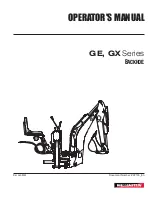
|
14
CRYSTAL® BATTERY USER MANUAL
3.
CHARGE AND DISCHARGE
SPECIFICATIONS
• Float (UPS) - Float Only
Requires full capacity discharge in a short period
of time once or twice a year.
The batteries are continuously in the float phase
until required to discharge, in most cases a simple
charger is designed to only supply a float
voltage/current and not have multiple phase
charge profiles that are required for effective
battery charging. Float applications require a
deep discharge purification cycle, or equalization
cycle, at least every 3 months to ensure the
battery chemistry remains active and to prolong
the use life of the battery.
• High Cyclic - Bulk/Absorption with no or
infrequent float
Requires a cyclic charge profile and more
frequent purification regime.
The batteries are frequently deeply discharged,
in most cases daily or in extreme cases multiple
times a day, in which charging consists of higher
voltage and current during the boost phase
followed by a reduced current absorption phase.
In extreme cases, the battery charge profile
seldom reaches the float or top-up phase,
effectively forcing the battery to operate in a
partial state of charge.
When the application requires a partial state of
charge use, a purification charge MUST BE
performed weekly and in less demanding
applications, twice a month.
IMPORTANT NOTE: Float Applications
During float/trickle charge applications, the
purpose is to replace the energy used by the internal
self-discharge chemical reactions to maintain it at
full charge. Generally, a power supply will deliver a
constant voltage between 13.5 volts and 13.7 volts
(typically 13.6 volts). This type of usage dictates that
a periodical purification charge must be performed
to maintain the batteries chemistry in a healthy state.
See section 3 for details on purification charge.
Due to the wide variations in float charging systems,
we have provided charge specifications in this manual
that will deliver the best possible results.
All lead-based batteries need to be put through the
three basic stages of charge BULK, ABSORPTION, and
FLOAT. If these stages are not achieved the battery
will NEVER be fully charged. If you intend to use
Crystal® batteries in a float application, then we
encourage you to contact the Green Rhino technical
team to discuss the application, ensuring you achieve
the best results from the Crystal® batteries.
All batteries have different charge requirements due
to the variations of lead and alloys used to make the
plates, since the pasting density, composition, and
the electrolyte solution are critical to the battery
operation. Hence it is essential to be informed on the
charging requirements specified in the user manual
of the battery manufacturer.
In this chapter, the focus is on the minimum
requirements to charge a Crystal® battery, since it is
the single most important part of the batteries’ life
and how it will perform in systems. Additional type
and range specific charging and care information can
be found in the datasheets on the
www.greenrhino-energy.com website. Please take
special care to comply with recommendations since
the system performance and any warranty will be
subject to correct charging procedures.
Battery system applications are usually defined into
the following usage conditions:
• Cyclic - Regular Bulk/Absorption/Float
Requires the battery to deliver all or most of its
stored energy once per day over a long period of
time.
The batteries are discharged daily between 50%
and 80% Depth of Discharge (DoD), followed
by a full charge cycle. These charging cycles, as
mentioned above, must occur at the
recommended temperature-compensated voltage
and current during the bulk or boost phase,
followed by a reduced current absorption phase
that is then ended with a float top-up phase at
a highly reduced charging current to ensure the
battery is fully charged and ready for the next
long discharge cycle.
• Standby - Float with the occasional Bulk/
Absorption/Float
Requires full capacity available for possible deep
cycle with less frequent discharges.
The batteries are less frequently discharged, 3
months or more between discharges, for
example, followed by a full charge as per the
cyclic use above. In most cases, this type of
application requires less frequent purification as
long as the charger is set to stop charging once
the battery is full or with pre-set timers that stop
the charging to prevent over-charging during
standby times















































